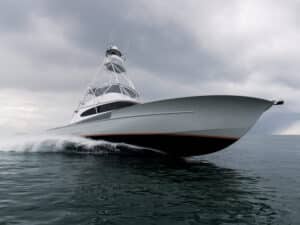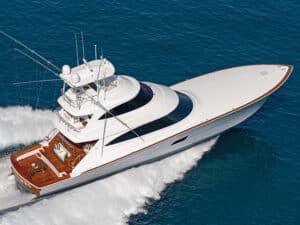A guy comes home and says to his wife, “Hey, honey, guess what? I finally found the boat I’ve been looking for. It has lots of rod holders, a prep station, tons of draining storage compartments, three fishing platforms … everything we need.” “You mean everything you need,” his wife replies. “I hope it’s not another one of those ‘fishing boats’ you tried to pass off as something we all can use. Does it have lots of seats for the kids and their friends?”
“Yes.”
“Does it have a place to store all their kneeboards and stuff?”
“Yes.”
“Is it comfortable and quiet? Stable? Does it have a changing room with a porta-potty?”
“Yes, it has all that,” he says.
“I won’t believe that until I see it,” she replies.
If this scenario sounds familiar, Cobia’s 226 Coastal Deck might be the solution to this age-old problem. Finally, a boat you can use to take the guys out fishing that the family also can enjoy.
As deck boats have evolved, they have continually been likened to “sport-utility” vehicles: boats that do practically everything. Like pontoon boats, their open-deck design makes them great for entertaining, and they often become the focal point of on-water parties. Unlike pontoon boats, their planing hull design allows owners to pull skiers with ease and reach top speeds in the upper 40s.
However, when manufacturers began to add fishing packages to deck boats, many came across as an afterthought to a boat designed for something other than catching fish. The packages provided a rod holder or two and maybe a place to hold the day’s catch, but beyond that, a lot of boats came up short. And if you wanted to go offshore, you had to bring the kidney belt because, quite frankly, many can’t handle the chop.
The 226 Coastal Deck differs greatly from the current crop of deck boats on the market. In keeping with Cobia’s focus, the 226 is designed with fishing in mind, which becomes apparent the moment you step across the transom.
Because the 226 is outboard powered, the transom is divided by the engine bay. A fishing platform on either side – each with cockpit access – provides a place from which to cast. Beneath each platform lies a draining compartment perfect for caught fish. The locker lids feature twist-to-unlock latches and a padded rubber nonskid matting – something we’ve never seen on a deck boat.
Step through to the cockpit. If the cushions are in place, you think, “No big deal.” Lift each cushion – all seven of them – and you’ll find a storage compartment with twist latches. All but two of them are self-draining, finished parts of the one-piece top deck assembly. Interestingly, the cushions fasten to the deck in such a way that allows you to open the locker without removing them. Pretty slick.
The helm station is designed without a tilt steering wheel, a feature we feel no boat should be without. But the 226 doesn’t need it. Sitting or standing, the wheel is in the right place. A footwell is ideally placed if you want to sit. If you stand, the seat provides bracing for the back of your thighs, and all gauges are visible from either position.
Walking forward, you’ll find what sets the 226 apart from other fishable deck boats. First, a 25-quart removable cooler fits snugly into its own recess. Farther forward, a drawer for pliers and tools sits atop a locker fitted with a rack specially designed to hold a kitchen garbage bag. Next to that, five rods can be stored: three upright and at the ready and two horizontally tucked behind the gunwale.
If that were all the fishing equipment the 226 had, it wouldn’t be as notable, but there is more. Three concealed, removable tackle drawers with storage beneath and a prep station above make the 226 a boat for serious anglers. The theme continues in the bow area with a step leading to the front fishing platform, which actually is the door that conceals the docking light, boarding ladder and anchor locker. And if you want other places to stand, remove a seat cushion and toss it into the cavernous head compartment. Each locker door is textured to provide sure footing.
Of course, all these fishing goodies and deck space mean nothing unless it performs, and the 226 doesn’t disappoint. The test boat came with Yamaha’s 150-horse Saltwater Series II EFI engine. Cobia is owned by the Japanese conglomerate. The engine is quieter than the spec-chart decibel readings would indicate. Most of the 104 decibels at the helm came from wind noise, something that probably could be cured with a taller windscreen. Sitting in the rear-most seat about a foot from the engine, the meter indicated a measly 89 decibels.
The engine pushed the 226 to a top speed of 42 miles per hour, which won’t terrorize any Cigarette boats, but it is ample for its intended use. Optimal cruising speed is between 25 and 30 mph. But what’s interesting is that a hull design that draws only 13 inches of water – drive up, of course – handles rough water as well as it does. Traversing a wind-whipped, wake-strewn section of the Intracoastal Waterway didn’t yield any of the annoying pounding that often accompanies shallow-draft hulls.
Summed up, the day you bring home a 226 could be as good for your spouse as it is for you. – Brett Becker
Cobia Boats
6725 Bayline Drive
Panama City, FL 32401
850-769-0311
http://cobiaboats.com







